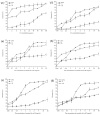The Chemical Composition and Functional Properties of Essential Oils from Four Species of Schisandra Growing Wild in the Qinling Mountains, China
- PMID: 29976902
- PMCID: PMC6100523
- DOI: 10.3390/molecules23071645
The Chemical Composition and Functional Properties of Essential Oils from Four Species of Schisandra Growing Wild in the Qinling Mountains, China
Abstract
The aim of this study was to investigate the chemical composition and functional properties of the essential oils from the plants Schisandra grandiflora (Wall.) Hook. f. et Thoms, Schisandra rubriflora (Franch). Rehd. et Wils., Schisandra sphenanthera Rehd. et Wils., and Schisandra propinqua (Wall.) Baill var. sinensis Oliv. collected in the Qinling Mountains. Under the optimum conditions of the ultrasonic-assisted extraction method, the extraction yields were 7.51% (S. grandiflora), 6.91% (S. rubriflora), 6.11% (S. sphenanthera), and 5.88% (S. propinqua). A total of 86 components were identified from four species of Schisandra and 16 components were shared among the essential oils of all samples with different contents. However, some components were identified only in a certain plant, for example, β-caryophyllen (S. grandiflora), α-bulnesene (S. rubriflora), and α-Chamigrene (S. propinqua). Terpenoids (sesquiterpenes and oxygenated sesquiterpenes), accounting for 73.87⁻82.08% of the total compounds, were the main components. Meanwhile, the antioxidant activities of the essential oils were evaluated through three free radical scavenging assays and a reducing power assay, which were related to the contents of the individual bioactive composition. These results provide a phytochemical foundation for the use of four species, and for the further study of the identification of Schisandra species.
Keywords: Schisandra; antioxidant activity; essential oils; ultrasonic-assisted extraction.
Conflict of interest statement
No potential conflict of interest was reported by the authors.
Figures





Similar articles
-
Microbial communities of Schisandra sphenanthera Rehd. et Wils. and the correlations between microbial community and the active secondary metabolites.PeerJ. 2024 Apr 26;12:e17240. doi: 10.7717/peerj.17240. eCollection 2024. PeerJ. 2024. PMID: 38685939 Free PMC article.
-
[Determination of lignans in four fruits of Schisandra genus in Qinling mountains].Zhong Yao Cai. 2013 Jul;36(7):1053-5. Zhong Yao Cai. 2013. PMID: 24417136 Chinese.
-
Chemical composition and antioxidant activity of essential oil from berries of Schisandra chinensis (Turcz.) Baill.Nat Prod Res. 2012;26(23):2199-203. doi: 10.1080/14786419.2011.636745. Epub 2011 Nov 21. Nat Prod Res. 2012. PMID: 22103398
-
Schisandra sphenanthera: A Comprehensive Review of its Botany, Phytochemistry, Pharmacology, and Clinical Applications.Am J Chin Med. 2021;49(7):1577-1622. doi: 10.1142/S0192415X21500749. Epub 2021 Sep 23. Am J Chin Med. 2021. PMID: 34559620 Review.
-
A review of polysaccharides from Schisandra chinensis and Schisandra sphenanthera: Properties, functions and applications.Carbohydr Polym. 2018 Mar 15;184:178-190. doi: 10.1016/j.carbpol.2017.12.058. Epub 2017 Dec 27. Carbohydr Polym. 2018. PMID: 29352909 Review.
Cited by
-
Microbial communities of Schisandra sphenanthera Rehd. et Wils. and the correlations between microbial community and the active secondary metabolites.PeerJ. 2024 Apr 26;12:e17240. doi: 10.7717/peerj.17240. eCollection 2024. PeerJ. 2024. PMID: 38685939 Free PMC article.
-
Prevention of supercritical carbon dioxide fluid extract from Chrysanthemum indicum Linnén on cutaneous squamous cell carcinomas progression following UV irradiation in mice.Exp Ther Med. 2024 Jun 20;28(2):330. doi: 10.3892/etm.2024.12619. eCollection 2024 Aug. Exp Ther Med. 2024. PMID: 38979021 Free PMC article.
-
Optimization of the Extraction Process and Biological Activities of Triterpenoids of Schisandra sphenanthera from Different Medicinal Parts and Growth Stages.Molecules. 2024 May 8;29(10):2199. doi: 10.3390/molecules29102199. Molecules. 2024. PMID: 38792061 Free PMC article.
-
The influence of storage conditions on the quality of Schisandra chinensis fruits: A integrated investigation of constituent and antioxidant activity.Heliyon. 2024 May 29;10(11):e32194. doi: 10.1016/j.heliyon.2024.e32194. eCollection 2024 Jun 15. Heliyon. 2024. PMID: 38882346 Free PMC article.
References
-
- Editorial Committee of Flora of China . Flora of China. Science Press; Beijing, China: 1996. pp. 258–260.
-
- Saunders R.M.K. Monograph of Schisandra (Schisandraceae) Syst. Bot. Monogr. 2000;58:1–146. doi: 10.2307/25027879. - DOI
-
- Smith A.C. The families Illiciaceae and Schisandraceae. Sargentia. 1947;7:1–244.
-
- Szopa A., Ekiert R., Ekiert H. Current knowledge of Schisandra chinensis (Turcz.) Baill. (Chinese magnolia vine) as a medicinal plant species: A review on the bioactive components, pharmacological properties, analytical and biotechnological studies. Phytochem. Rev. 2017;16:195–218. doi: 10.1007/s11101-016-9470-4. - DOI - PMC - PubMed
-
- The State Pharmacopoeia Commission of P. R. China . Pharmacopoeia of the People’s Republic of China. China Medical Science Press; Beijing, China: 2015. p. 244.
MeSH terms
Substances
LinkOut - more resources
Full Text Sources
Other Literature Sources
Medical

